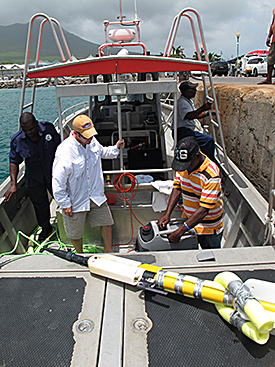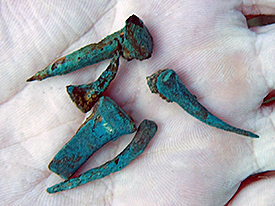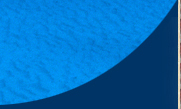
Diving
5 July 2011
By Chris Cartellone

Preparing survey equipment on police launch. (Photograph by Chris Cartellone.)
This week proved quite eventful in many ways, full of challenges and rewards. Justin and I spent Tuesday on the water with the Police Boat attempting to run survey lanes with a magnetometer. I say attempting because surveying is not as simple as it would seem. It begins with unpacking and testing all equipment at the house, and loading a planned survey design into a laptop computer using Hypack data recording and navigation software.
Once at the boat we must set everything up including a GPS, laptop computer for data, external computer monitor for the boat pilot to follow the planned navigation lines, a generator as a power supply, the magnetometer, and many, many cables connecting everything. We ran into some initial difficulty making sure the magnetometer and GPS were correctly talking to the software and recording computer. After the bugs were fixed, we were ready to go, but then we had a problem with the generator. Fortunately, the police knew a mechanic, named Bing, who met us at the dock and fairly quickly resolved the problem.
Finally, we returned to the water and began our survey lines. This required coaching the police officer on how to read our navigation software and the importance of driving very straight lines for data collection. He must repeatedly drive for hundreds of meters in straight, parallel lines, back-and-forth. We intentionally surveyed directly over the known cannons on the site to capture a magnetic archaeological signature. This known target will help us assess the remaining data and identify other potential cannons. We could not complete the survey due to time constraints, and intend to resume the effort this week.

Justin Parkoff plotting artifacts on site plan. (Photograph by Chris Cartellone.)
For the remainder of the time we shifted our attention to locating and recording artifacts and making use of the excellent divers associated with the Marine Biology Field School from Finger Lakes Community College. The wreck is located in an area that is shallow, and heavily scoured by currents, storms, and hurricanes throughout the years. As a marine biologist, Professor James Hewlett helped validate the environmental context and archaeological site formation process from his many years spent studying coral reefs and the condition of marine life.

James Hewlett recording High Definition video. (Photograph by Paul Diamond.)
Even in such a high-energy environment the team observed several artifacts, including some surprisingly small ones. Large finds included several new ballast, many pieces of disarticulated and concreted iron, and even a new gun that appears to be a carronade. This will require further study from the measurements and photographs to compare to historical records once we return from the project. What makes it different than the other carronade on site is the general shape with cascabel and trunnions, but it still has a very large circumference relative to its length. For now, it will perplex us.

Copper tacks discovered on seafloor. (Photograph by Diana Stellar.)
Among the smaller finds include various copper fasteners including tacks, bits of edging from what probably was copper sheathing, lead, and even a couple musket balls. All of these bits will prove very diagnostic and help in the interpretation stages of research. I have initiated the permit process to recover a few small pieces, conserve them at Texas A&M University's Conservation Research Laboratory, and return them in a year. These would become the centerpiece of a wreck exhibit in the island's historical museum. An important aspect of our field research is to share our finds with the people of Nevis, and enhance their heritage tourism resources, thereby encouraging site protection.
Overall, we had a fairly successful week. The Finger Lakes folks had to leave this past weekend. As we sadly said goodbye and thanked them for their contribution, we welcomed Professor Marco Meniketti and students from San Jose State University that will join us for the remaining time here. Dr. Meniketti will be teaching a terrestrial archaeological field school on Nevis to study a sugar plantation. We have coordinated schedules to allow a few of his students and himself to aid us on our project. We look forward to running the magnetometer again this week, and recording more of the wreck.
If you have questions or comments, please email us at cartellone@tamu.edu.
Return to MUA Project Journals home page.

